How to make sourdough starter
The path to great sourdough bread begins with healthy starter.
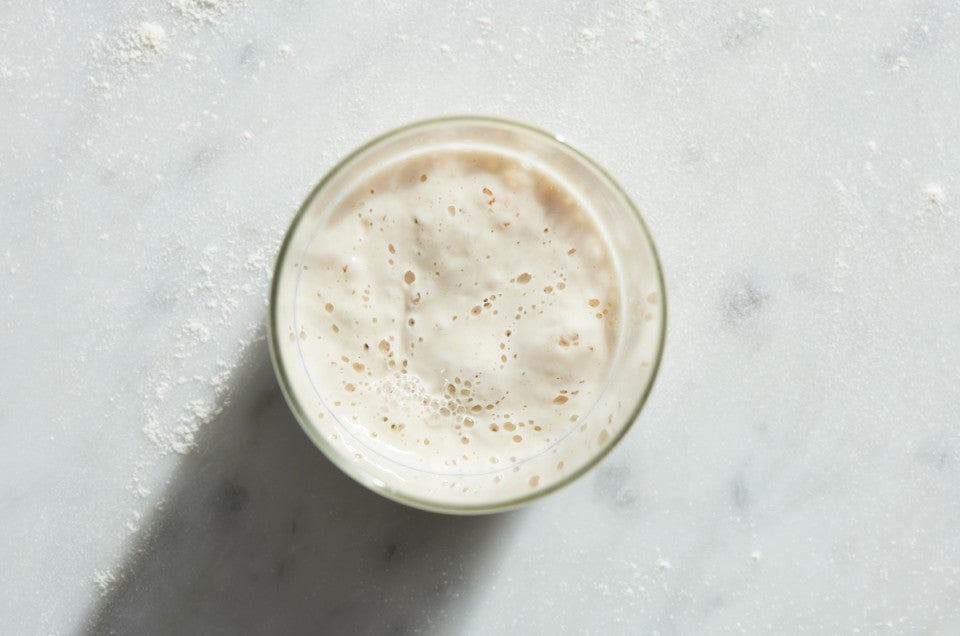

Have you ever wondered how to make sourdough starter?
Whether it conjures up a crusty loaf of bread or a bubbling crock of starter, sourdough is a treasured part of many bakers’ kitchens. But where does the path to sourdough bread begin? And how do you start?
Start in your own home kitchen, with flour and water. And begin by learning how to make your own sourdough starter.
First, a word of advice. Sourdough baking is as much art as science. This method for making sourdough starter isn't an exact match for the one you read on another site, or in a cookbook, or in your great-grandma's diary. If you have a process you've successfully followed before, feel free to stick with it. Or try this one and compare.
The following timeline assumes you can find a relatively warm place (68°F to 70°F) to grow your starter. More on that below. We also highly recommend using a scale: It will make this process much more accurate and much less messy. (But using measurement cups works, too, if necessary.)
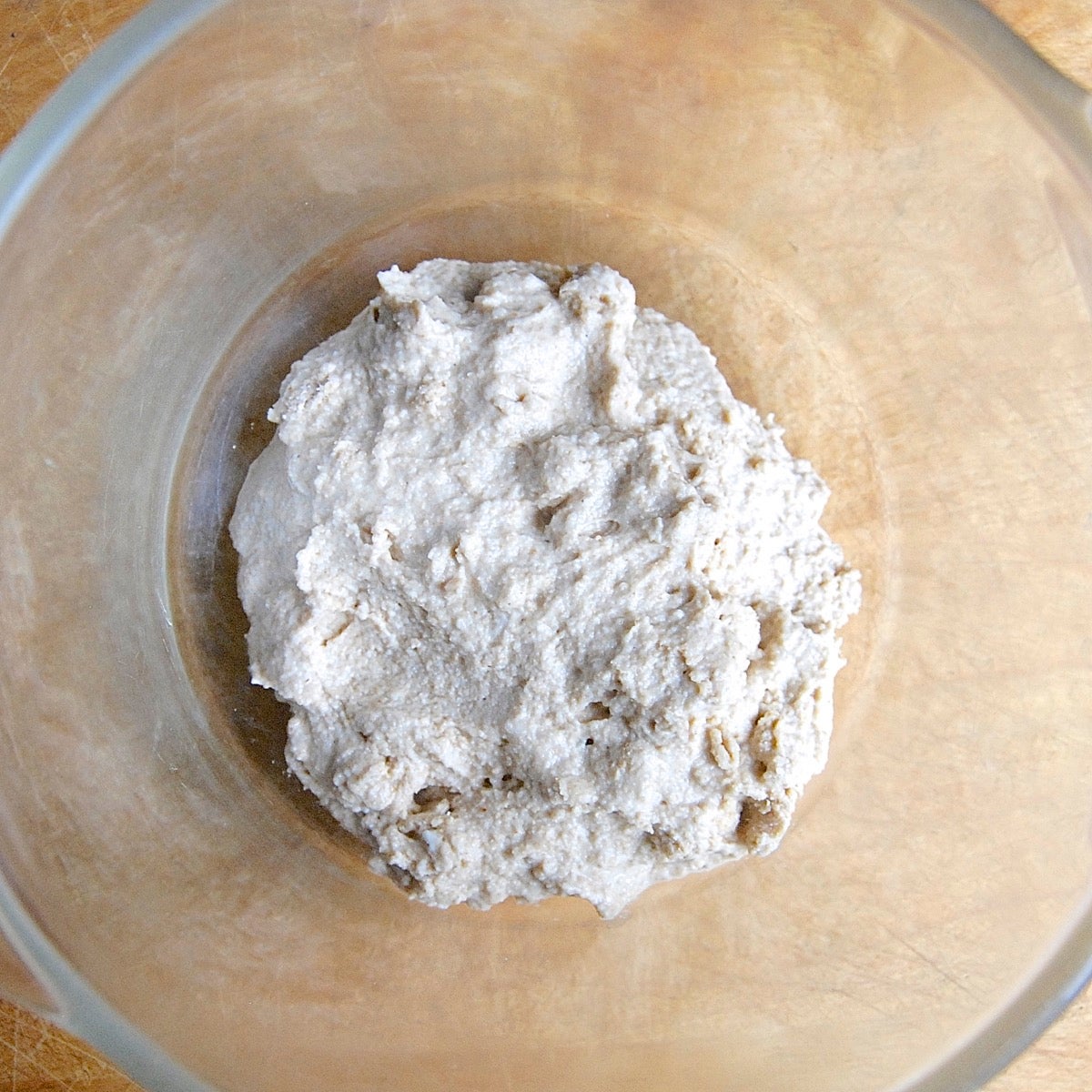
Combine 113g (1 cup) whole rye flour (pumpernickel) or whole wheat flour with 113g (1/2 cup) non-chlorinated cool water in a non-reactive container. Glass, crockery, stainless steel, or food-grade plastic all work fine for this. Stir everything together thoroughly; make sure there's no dry flour anywhere. Cover the container loosely and let the mixture sit at warm room temperature (about 70°F) for 24 hours.
A note about flour: You'll notice whole grain flour (whole wheat or rye) is used at the beginning of the process. This is because whole grains contain more nutrients and sourdough-friendly microorganisms than all-purpose flour. (Learn more in our post: Sluggish starter? Add a little whole grain flour.) After this first day, switch to using all-purpose flour.
A note about water: You also may have better results if you feed your starter with non-chlorinated cool water; from now on, we'll refer to this simply as "water."
A note about room temperature: The colder the environment, the more slowly your starter will grow. If the normal temperature in your home is below 68°F, we suggest finding a smaller, warmer spot to develop your starter. For instance, try setting the starter near a baseboard heater, or atop your water heater, refrigerator, or another appliance that might generate ambient heat. Your oven, turned off but with the light on, is another option, as is setting the container of starter on a folded dish towel laid atop a heating pad on its lowest setting. A temperature-controlled bread proofer or a sourdough home is the absolute ideal solution; if you bake lots of bread, consider investing in one of these tools.
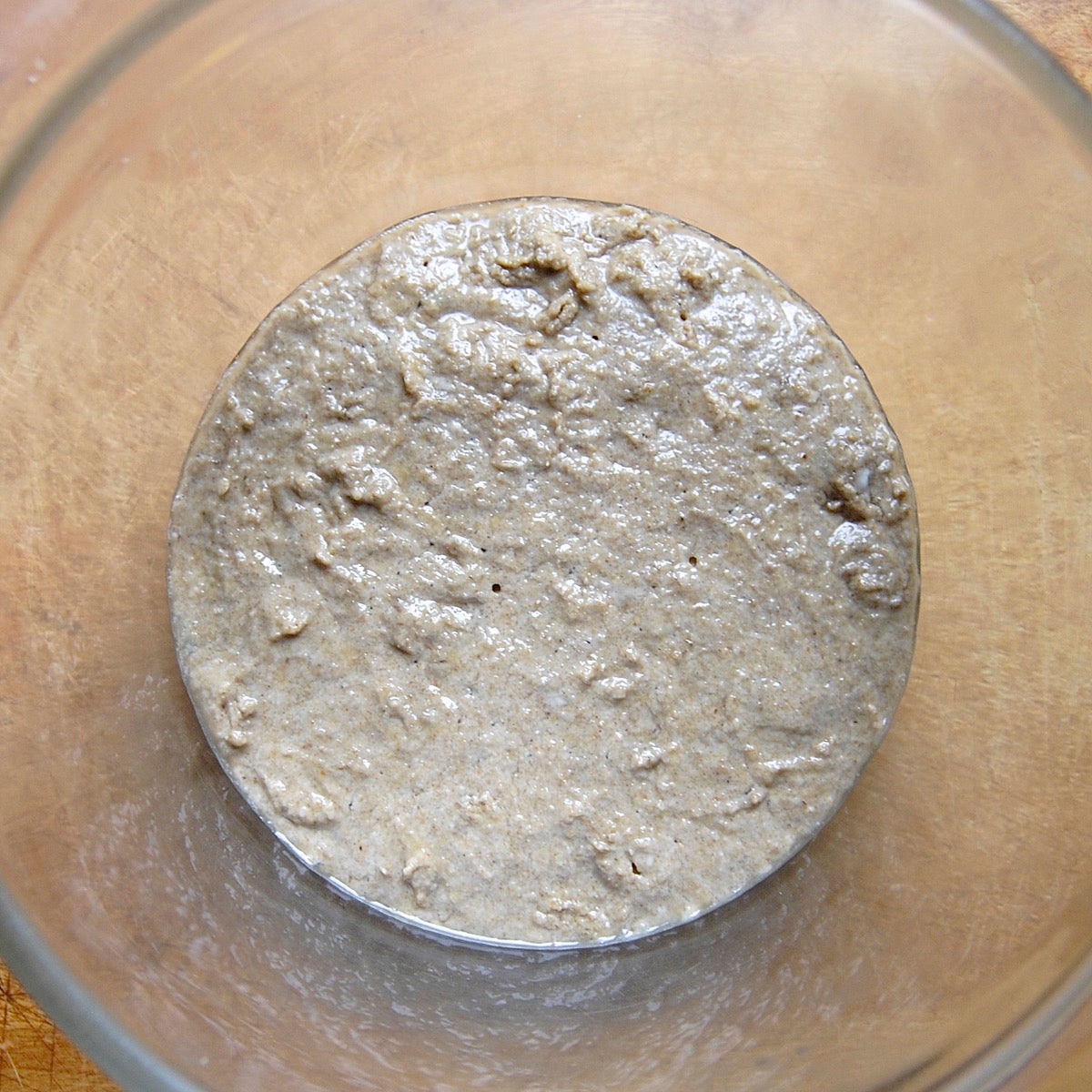
You may see no activity at all in the first 24 hours, or you may see a bit of growth or bubbling. Note that this starter looks fairly inert when viewed from up top.
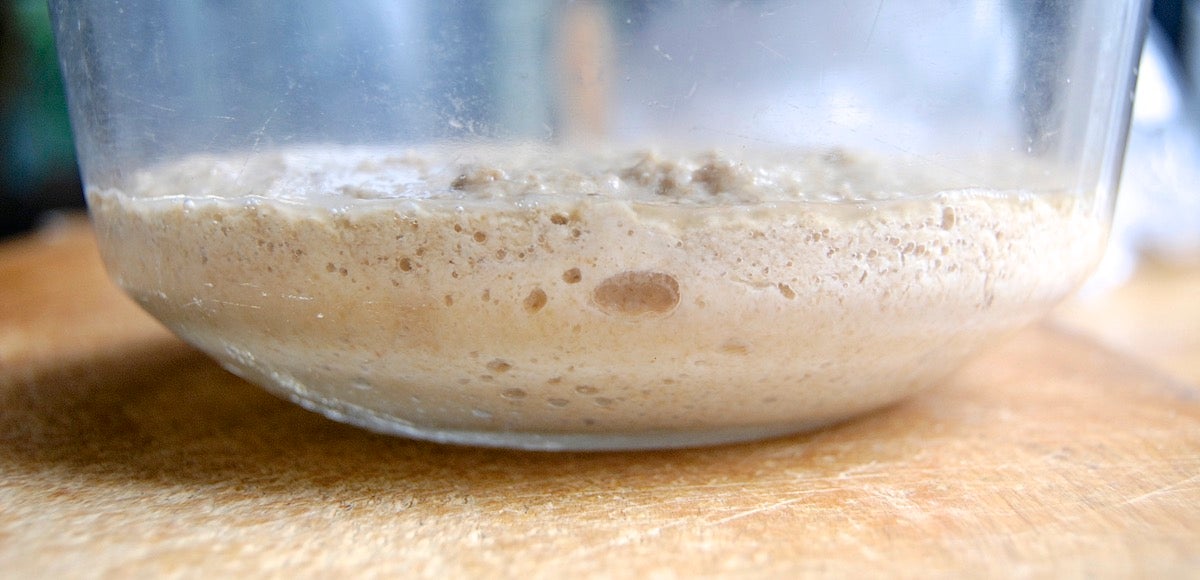
But when viewed from the side, you can see bubbles starting to form under the surface.
Either way, discard half the starter (113g; about 1/2 cup), and add to the remainder 113g (a scant 1 cup) King Arthur Unbleached All-Purpose Flour and 113g (1/2 cup) cool water (if your house is warm); or lukewarm water (if it's cold). Mix well, cover, and let the mixture rest at room temperature for 24 hours.
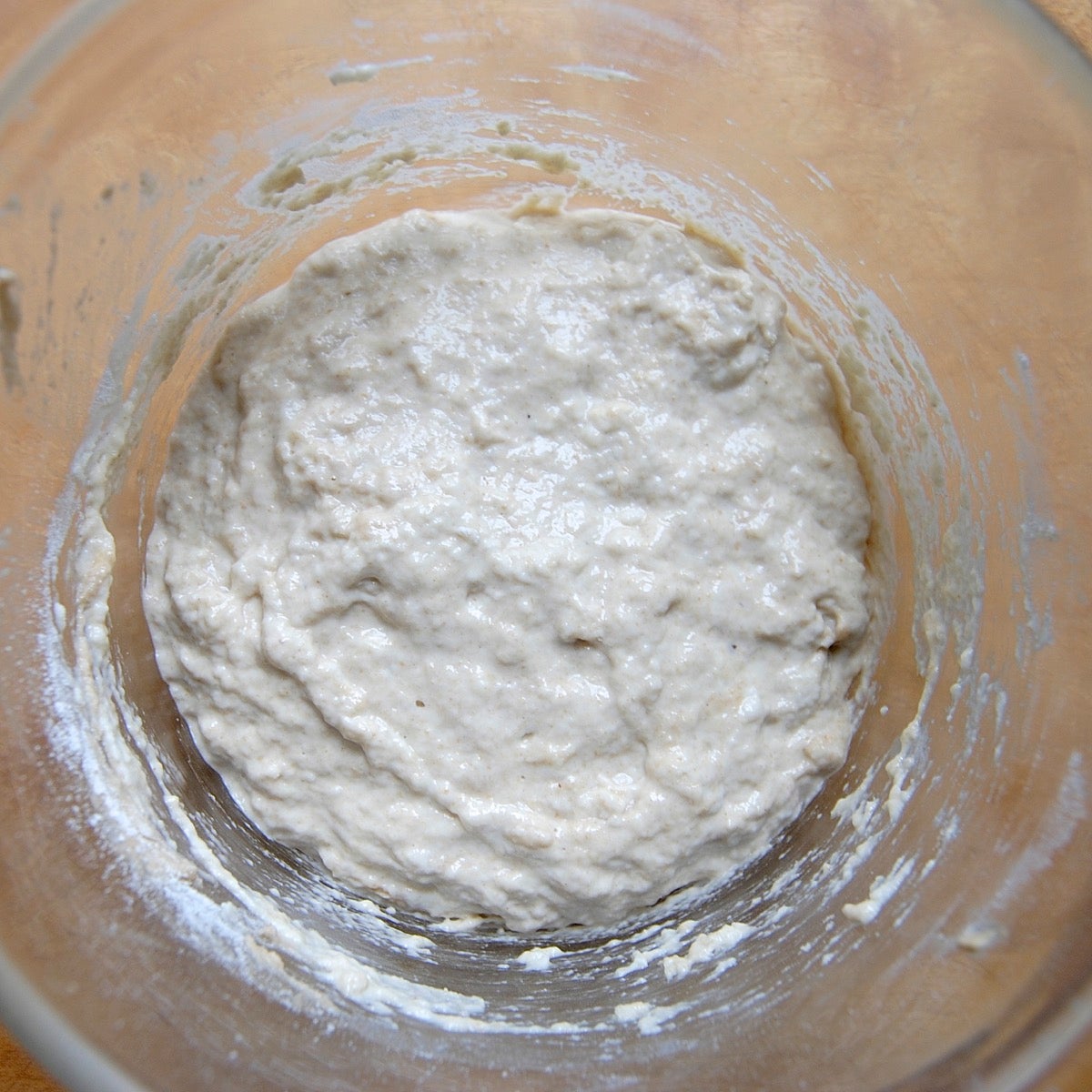
It's necessary for three reasons. First, unless you discard, eventually you'll end up with way too much starter. Second, keeping the starter volume the same helps balance the pH. And third, keeping the volume down offers the yeast more food to eat each time you feed it; it's not fighting with quite so many other little yeast cells to get enough to eat.
Also, you don't have to discard it if you don't want to; you can give it to a friend, or use it to bake. There are quite a few recipes on our site using "discard" starter, including sourdough pizza crust, sourdough pretzels, and my all-time favorite waffles. And if you still aren't comfortable discarding so much, consider maintaining a smaller sourdough starter.
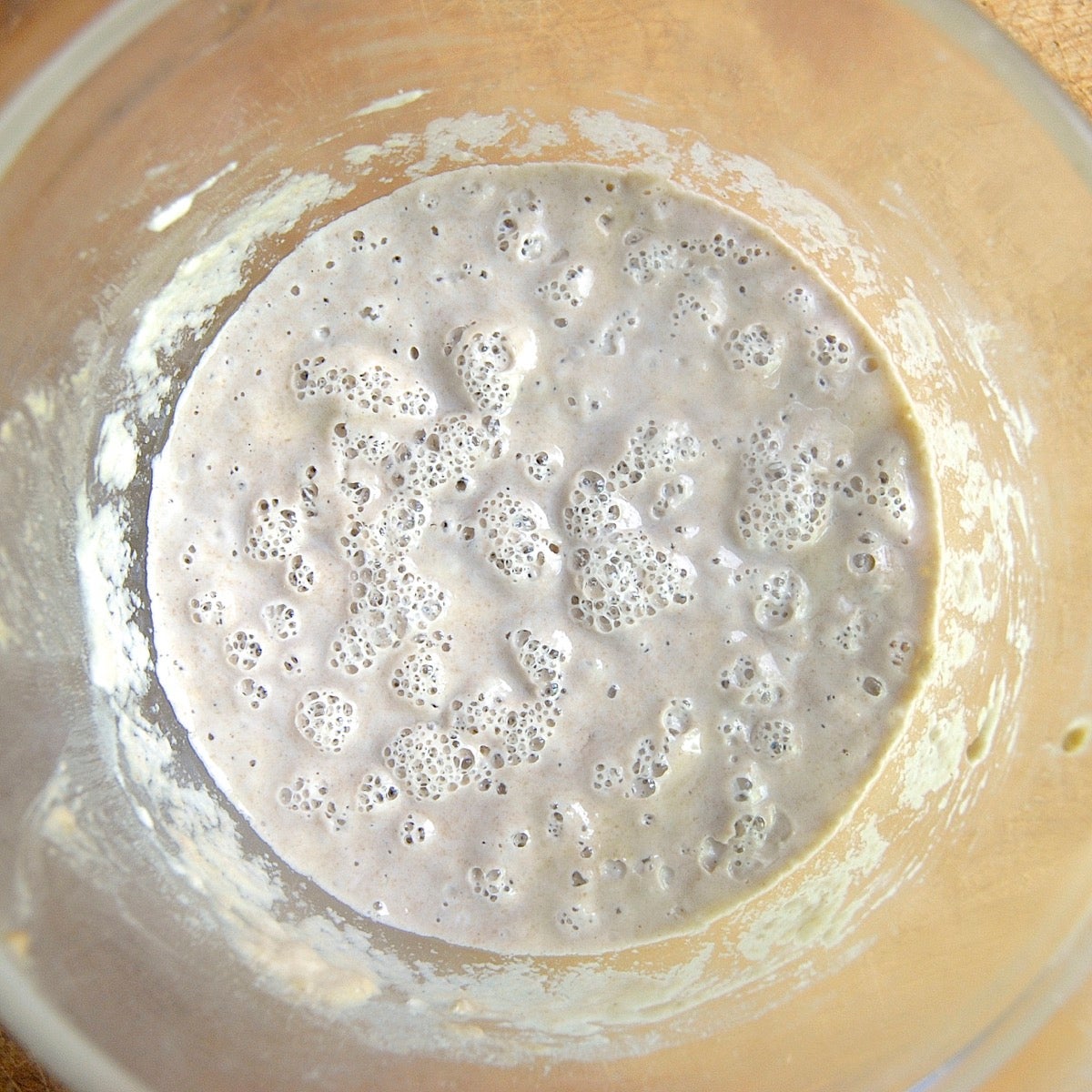
By the third day, you’ll likely see some activity — bubbling; a fresh, fruity aroma; and some evidence of expansion. The somewhat darker hue your starter got from its whole wheat beginnings will fade as you continue to feed it with all-purpose flour. It’s now time to begin two feedings daily, as evenly spaced as your schedule allows.
For each feeding, weigh out 113g starter; this will be a generous 1/2 cup, once it’s thoroughly stirred down. Discard any remaining starter.
Add 113g (a scant 1 cup) King Arthur Unbleached All-Purpose Flour and 113g (1/2 cup) water to the 113g starter. Mix the starter, flour, and water, cover, and let the mixture rest at room temperature for approximately 12 hours before repeating.
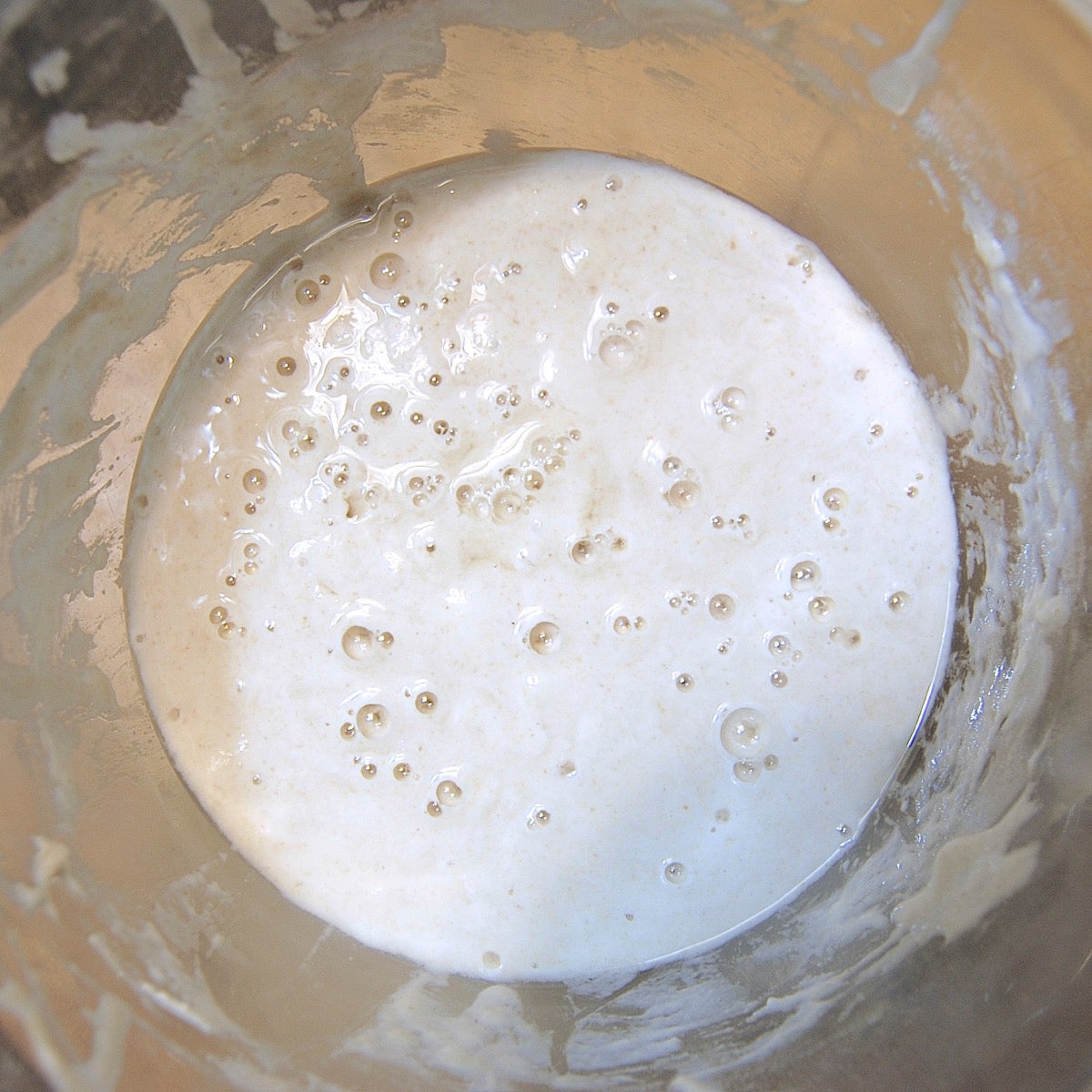
Here's the starter after its 12-hour rest. It may actually appear to be bubbling less than it did initially; this is normal.
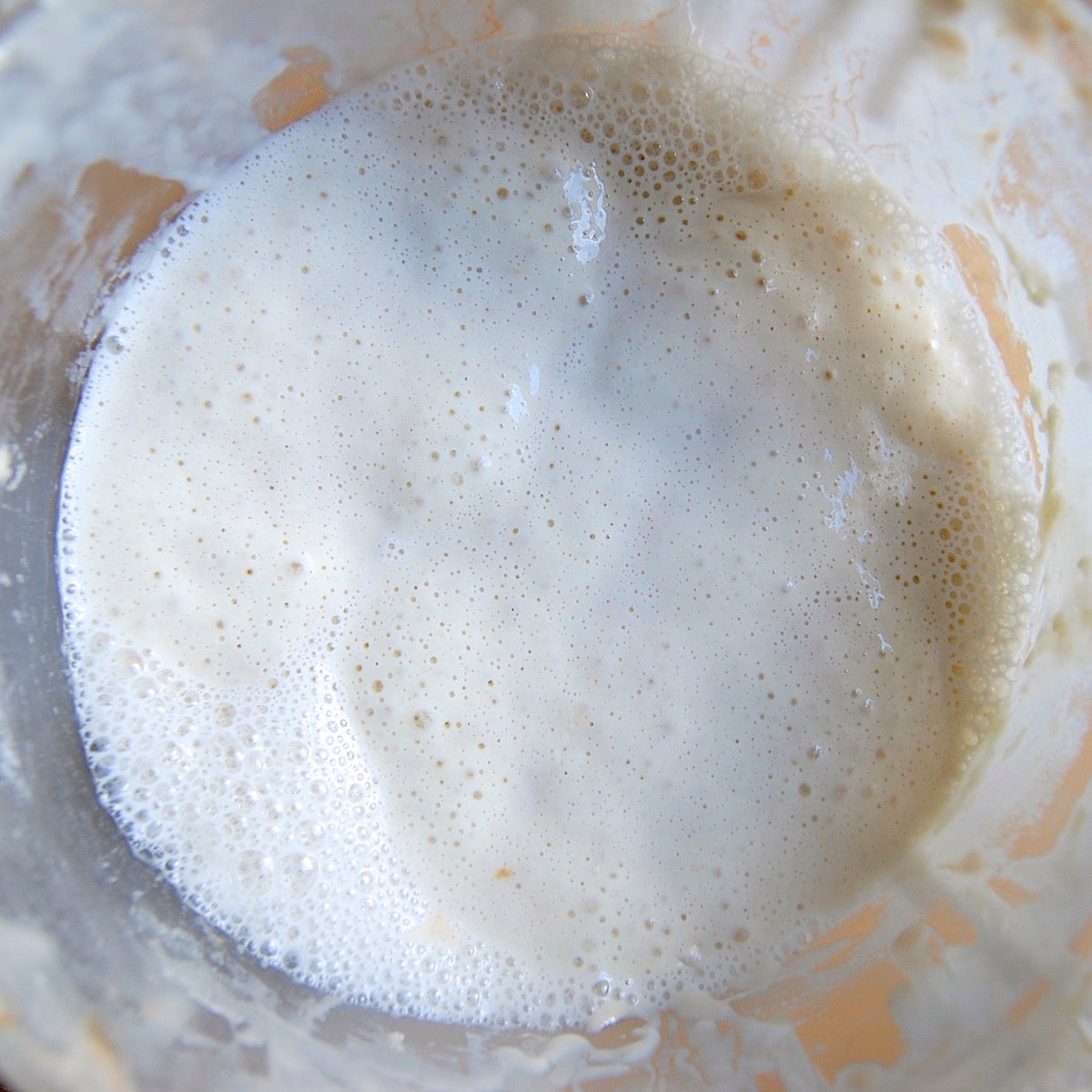
Repeat two-a-day feedings on days 4, 5, and as many days as it takes for your starter to become very active — almost foamy. If your starter is in cool surroundings, you may find it takes up to 2 weeks (or perhaps even longer) to get going.
When it shows a markedly different type of bubbling, though, it's just about ready to use.
When you stir it down and feed it this time, make a note of how high it comes on the bowl or jar. You'll know it's ready to use in baking when it doubles in size in about 4 to 6 hours. You'll see lots of bubbles; there may be some little “rivulets” on the surface, full of finer bubbles. The starter should also have a tangy aroma — pleasingly acidic, but not overpowering.
When it gets to this point — doubling in size in 4 to 6 hours — give it one last feeding. Discard all but 113g (a generous 1/2 cup). Feed as usual. Let the starter rest at room temperature for 4 to 8 hours; it should be active, with bubbles breaking the surface.
Remove however much starter you need for your recipe (no more than 227g, about 1 cup); and transfer the remaining 113g of starter to its permanent home: a crock, jar, or whatever you'd like to store it in long-term. Feed this 113g of starter with 113g of flour and 113g of water.
Let it bubble and become active for several hours before covering it and placing it in the refrigerator.
No worries. If, after a week, your starter isn’t ready, don’t lose heart; keep feeding it regularly, and it will gain strength — really! Be patient. The conditions in your kitchen may be more or less conducive to building a starter, depending on room temperature, the season, humidity, or how much you’ve been baking.
Remember, the keys to developing a successful starter are:
Once your starter is doubling in size six to eight hours after being fed, it's ready to start baking. Here's what it should look like:
Now you're ready to bake with your starter! Try one of these beginner-friendly recipes:
No-Knead Sourdough Bread: This low-technique recipe relies entirely on sourdough starter for leavening. With a bubbly, active sourdough starter, a little bit of patience, and minimal effort, you’ll have a stunning, delicious loaf — all made without kneading.
Pain de Campagne (Country Bread): If you’re looking for a bit more of a challenge, try this recipe. Using unfed sourdough starter, minimal kneading, long fermentation, and baking in a hot Dutch oven are some of the techniques that make this naturally leavened, bakery-quality loaf simple to make at home.
Rustic Sourdough Bread: Because this recipe includes commercial yeast as well as starter, you're guaranteed a good, strong rise — even if your starter isn't quite up to snuff. If you’re just beginning to bake with sourdough starter and want some extra reassurance of success, this loaf is a great choice.
Note: In these recipes “ripe sourdough starter” refers to starter that has been fed and then doubled in volume and is showing signs of just beginning to sag under its own weight. The timing will be different depending on your sourdough starter and conditions, but generally, this occurs roughly eight hours after being fed. See more: Ripe sourdough starter: Here's what that means.
Don't worry — everything will be just fine. Starter is remarkably resilient. If you missed one feeding, just pick back up with your typical routine and your starter will settle in easily. If you missed a few feedings, simply keep feeding at room temperature every 12 hours until it doubles in size within 4 to 8 hours. Learn more in our post: What if I forgot to feed my starter?
Sourdough starter should smell sharply sour but "clean," with no overtones of spoilage, or any oddly chemical smell (think acetone). While the aroma of sourdough may make you draw back simply from its strength, it shouldn't be distasteful.
When your starter is neglected for an extended period, the liquid on top tends to turn from clear to dark-colored. That's OK; simply stir the liquid back into the starter and feed it the meal it's desperately craving. However, if your starter shows visible signs of mold, or an orange or pink tint/streak, or smells putrid, throw it out; it's been invaded by harmful microorganisms, and it's time to start over.
Want something printable to follow? See our recipe for Sourdough Starter.
Next: Maintaining your starter
Cover photo by Mark Weinberg; food styling by Liz Neily.
February 6, 2022 at 4:42pm
In reply to It keeps saying 4 ounces (1… by Hannah Cousar (not verified)
Hi Hannah, the ounces we are referring to is a weight measurement, not fluid ounces (which is a volume measurement). When you discard half after the first feeding that should leave you with about 1/2 cup (4 ounces, 113g) of starter, to which you will feed 1/2 cup (4 ounces, 113g) of water and 1 scant cup (4 ounces, 113g) of AP flour. So, subsequent feedings for this starter should look like this: 1/2 cup (4 ounces, 113g) starter + 1/2 cup (4 ounces, 113g) water + 1 scant cup (4 ounces, 113g) unbleached all-purpose flour.
January 13, 2022 at 10:11pm
I'm making the sourdough starter for the first time today. Mixed 1 cup whole wheet flour with 1/2 cup water. It is very dry. How wet is it supposed to be? Not even sure it would make a dough ball if I tried to roll together
January 15, 2022 at 12:37pm
In reply to I'm making the sourdough… by Phyllis A Andres (not verified)
Hi Phyllis, this first feeding does tend to be thicker, partly because whole grain flours absorb more liquid than our unbleached all-purpose flour does. In addition, it's easy to add extra flour when measuring by cups, which will make for a thicker consistency. It's fine to add a little more water to be sure that all the flour is moistened and there are no dry pockets of flour, but don't worry if this first feeding seems very thick. For future feedings, we would recommend either measure by weight, or using this method to measure your flour by volume.
November 18, 2021 at 1:14pm
Hi, I was wondering if I could use the whole wheat flour to do this? And make the sour dough bread with whole wheat flour?
November 19, 2021 at 3:36pm
In reply to Hi, I was wondering if I… by Alice (not verified)
Hi Alice,
Yes you can make 100% whole wheat starter. You may find you need to decrease the flour slightly to prevent your starter from getting too thick. You'll shoot for a consistency similar to cake or brownie batter, nice and gooey.
November 12, 2021 at 12:42pm
Hi! Just about to use my starter for the first time (yay!) - just wondering once it's being stored in the fridge, is there any prep needed before using it again? Or just take the 1 cup needed for the recipe, feed it, and put it back in the fridge? Thanks so much :)
November 13, 2021 at 11:42am
In reply to Hi! Just about to use my… by Chloe Brennan (not verified)
Hi Chloe, once your starter goes in the fridge it can sometimes require a little reviving before you use it in a bread recipe, especially if it's been stored there for a week or more. This is particularly true for naturally leavened (no added yeast) bread recipes that call for "ripe" or "fed" starter. Ripe means starter that has been fed at room temperature and allowed to rise to its highest point. It's considered ripe when it's at this high point, or just beginning to fall. Depending on how long your starter has been stored in the refrigerator it can sometimes take a few room temperature feedings to bring it back to its normal aroma and rising behavior. Once it's doubling in size within 6-8 hours after a feeding, and has a pleasant aroma, then it's ready to add to your bread recipe. On the other hand, recipes calling for "discard" don't require any reviving, and you can generally use discard straight from the refrigerator.
Once you're ready to return your starter to the refrigerator, just give it another feeding and let it sit out for a few hours, or until it starts bubbling, before you stick it in the fridge.
November 2, 2021 at 5:10pm
Thank you for your response earlier. I am one last question. I am on my 4th day and my starter hasn't risen at all. On the second day, it rose to over half and then fell. Then, after I fed it, it hasn't risen at all and it just has a few bubbles on the top. The temperature is around 75 F so that shouldn't be a problem. I tried boosting the starter with some whole wheat flour when I fed it but that hasn't done much. Does rising come later on? Thanks!
November 2, 2021 at 5:31pm
In reply to Thank you for your response… by Titus (not verified)
Hi again Titus! Starters can be confusing at the best of times, and those first days of feedings see a lot of changes. The slow down in fermentation on days 4,5,6 is perfectly normal. New bacteria are starting to form and it changes the behavior of the starter. Keep up with the feeding and by day 6, 7 most starters show more growth again. It will be more moderate than when you first started, but it's really what you're shooting for.
We have two excellent troubleshooting guides for starters online here:
https://www.kingarthurbaking.com/blog/2018/03/09/sourdough-starter-troubleshooting-2
https://www.kingarthurbaking.com/blog/2018/03/12/sourdough-starter-troubleshooting-part-2
We hope you find this information helpful. Don't forget to check out our Complete Sourdough Guide, too!
November 2, 2021 at 12:53am
I have used my starter once and feed it. On day 3, my starter smells like apples. It’s bubbling nicely and doubled and fell. I was going to move it to the fridge and smelled it and it smells slightly like apples.. wondering if this is ok or not. It is slightly sour smelling just with an apple smell to.
Pagination